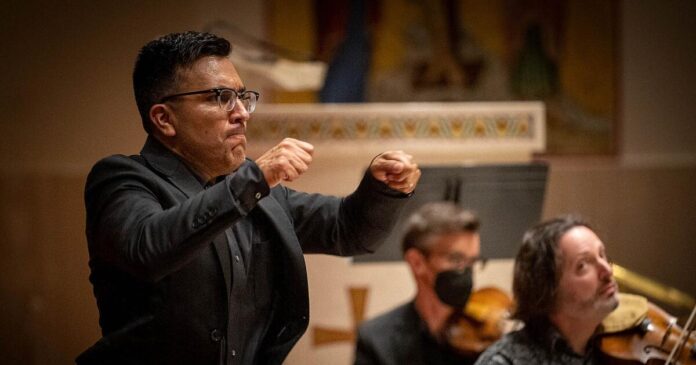The Bach Collegium San Diego launched its 21st season Friday evening. San Diego has been the beneficiary of Ruben Valenzuela’s scholarship and vision since he started his ensemble in 2003, and they leaped into their third decade in much the same way they have the preceding two, with a program thoughtfully conceived and expertly played.
Friday evening’s concert in Point Loma, the program was repeated on Saturday in Cardiff by the Sea, was emblematic, showcasing major late works by Carl Phillip Emanuel Bach and his godfather Georg Philipp Telemann, whose styles show their respective evolutions at the peak of their abilities.
The concert began with Franz Xaver Richter’s Adagio and Fugue in G minor, a work for string ensemble that helped to set the rhetorical stage for the headlining pieces. Richter’s works speak of his origins both as a student of the Renaissance counterpoint teacher Johann Fux and as a denizen of the Mannheim musical scene, where a new and exciting orchestral style was born.
The adagio, with pulsating string textures and grinding suspensions over dutiful baroque harmonic sequences leads into an aggressive, if academic, fugue. The Collegium’s string players made the most of the explosive dynamic changes that typify the Mannheim School, and their period-instruments lent textural clarity to Richter’s complex counterpoint.
C.P.E. Bach’s “Concert Doppio,” or “Double Concerto” for fortepiano and harpsichord, is a delightful and brilliant tour of the history of the keyboard, placing the harpsichord, favored by his father Johann and earlier generations, beside the fortepiano, the early version of our modern piano. Emanuel Bach is associated with the proto-classical “Empfindsamer Stil,” or “sensitive style,” one characterized by sudden changes in mood and texture (distinct from the Baroque tendency to have one affect dominate an entire movement).
Bach’s writing for the two keyboards is itself a treatise on how to imbue instrumental writing with rhetorical and emotional content, with the two keyboards — one old and one new — often trading the same material for timbral contrast. Harpsichordist Michael Sponseller’s deft, fluid passagework was impressive, and fortepianist Sylvia Berry was, as she has been in the past, bringing exquisitely precise dynamic shadings and articulation to delicate moments.
Berry is a subtle powerhouse who coaxes great force out of what might seem like a smaller instrument, and the interplay between her tactile control and Sponseller’s supple virtuosity was riveting. Valenzuela’s ensemble was in top form, with a string group augmented a la early Haydn, adding Baroque flutes and natural horns, each instrumental group played with balance and gusto.
While Telemann’s dramatic cantata “Ino” for soprano and ensemble was written late in the composer’s life, it represents him at the height of his powers, in full and astonishing command of the dramatic opportunities that opera (and the associated, unstaged, cantata genre) offered. Whether Telemann heard it performed is not known, though C.P.E. Bach directed a performance of it in 1768, a year after Telemann’s death.
Briefly, Ino was the sister of Semele, mother of Dionysus. Afoul of the goddess Juno, she is pursued by her mad husband Athamas, who is determined to kill her son Melicertes. Fleeing the grasp of Athamas, Ino leaps off a cliff into the sea with Melicertes, whom she loses, though sea nymphs rescue him, and ultimately Ino is transformed into the goddess Leukothea.
Musically, “Ino” is one of Telemann’s most intense and gripping works. The orchestra acts as a raving chorus, mirroring and amplifying Ino’s emotions, as she laments, accuses, and celebrates. The soprano Clara Rottstalk was thrilling at every turn, with a silken voice capable of extraordinary power and a dramatic approach that revealed a sophisticated understanding of her character. Her several free cadenzas, as in “Meint ihr mich?” were especially fine.
Valenzuela opted for tempi fierce enough to match Ino’s mercurial sensibilities, and the ensemble played with a polished unity and great force, shifting wildly between gears to communicate Telemann’s reading of the libretto with a vitality that was immediate and remarkable.
Schulze is a freelance writer.



